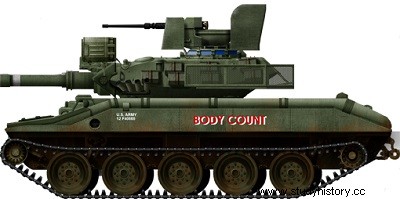
Type :light tank.
Crew :4 men.
Armament: a 152mm cannon/missile launcher; a coaxial 7.62 mm machine gun; a .50 anti-aircraft; 4 smoke canister launchers on each side of the turret.
Shielding: secret.
Dimensions:
length 6.299 ni;
width :2.819m;
height (overall):2.946 m.
Weight in combat order: 15.83 t.
Ground pressure: 0.49 kg/cm2.
Engine: Detroit Diesel 6V53T 6 cyl. diesel, developing 300 hp at 2,800 rpm.
Performance:
road speed :70 km/h;
speed on water speed:5.8 km/h;
range: 600 km;
vertical obstacle: 0.838 m;
clear cut: 2.54 m;
slope: 60%.
Service time: introduced in 1966 in the US Army and still in use.
In August 1959, the U.S. Army issued a tender for "a new armored vehicle superior to any existing equipment in its own army and that of any adversary". The following year, the Allison Division of the General Motors Corporation received a research contract for a vehicle called the Armored Reconnaissance Air-borne Assault Vehicle (ARAAV).
The machine, called for reconnaissance missions and anti-tank missions, was to replace both the light tank M41 and the 90 mm self-propelled anti-tank M56. The first prototype, designated XM55 1, was completed in 1962 and followed by eleven other prototypes. Late in 1965, a production contract was awarded to Allison, and the first production vehicles were ready in 1966 under the designation M551, or Sheridan.
Hardly had manufacturing had began that many deficiencies came to light and as a result, all vehicles coming off the line had to be immediately stored because they were unfit for service.
Later, the entire Sheridan/"Shillelagh"/M60A2 program came under review by an Armed Forces Board of Inquiry and one of the witnesses went down in legend when he said during one of the sessions:" We have so many Sheridans that they are starting to come out of our ears. »
The problems arose in three main areas:first, the automotive characteristics of the vehicle, then the "Shillelagh" missile system, finally the caseless ammunition. It took almost four years to overcome all the difficulties and in 1968 the M551s were deployed to Vietnam where the actual combat revealed other shortcomings which were also eventually filled.
From then on, the M551 was delivered to American units on United States soil. in Germany and South Korea. Finally, the machine was tested by several other armies, in particular the Australian army, but was not adopted by any.
Production ended in 1970 on the 1,700th example.
Sheridan's hull is all aluminum while the turret is wrought steel. The driver has his position
at the front of the hull, the three other crew members in the turret, the loader on the left, the gunner and the tank commander on the right. The engine and transmission assembly are located at the rear of the hull; the torsion bar suspension includes five road wheels, the sprocket at the rear, the idler wheel at the front. There are no support rollers.
The Sheridan's most interesting feature is its armament, a 152mm cannon/missile launcher that points in elevation from -8° to +19° and in 360° azimuth. A 7.62 mm machine gun is mounted in the axis of the main armament, a Browning .50 on the command cupola. This last weapon cannot be used from the inside and today, the experience acquired in Vietnam makes it very often equipped with a shield.
The 152 mm gun/missile launcher, later fitted to the M60A2 and MBT-70, can fire either the "Shillelagh" missile or a range of conventional ammunition including HEAT- T-MP, WP or shrapnel.
All these projectiles have combustible casings, which was one of the problems the tank suffered from at the start of its career. Often 'the combustion was incomplete and when the breech was opened after the firing, there were casing fragments, some of which were still burning and could fail in the combat chamber.
The "Shillelagh" missile , developed by the US Army and the Philco-Ford Corporation, has a maximum range of about 2,000 m. The missile is guided by the gunner who simply has to keep his line of sight on the target to be sure of a hit. The missile itself weighs 26.7 kg and is powered by a single solid fuel engine whose time combustion time is 1.18 seconds.
As soon as the missile leaves the tube, four fins deploy at the rear and bring it to the target thanks to an infrared guidance system , which frees the gunner from estimating the distance and taking into account the movement of the enemy machine.
The Sheridan usually carries 8 missiles and 20 shells but several combinations are possible depending on the circumstances; moreover, it is loaded with 1,000 rounds of .50 and 3,000 rounds of 7.62 mm.
The tank is equipped with a buoyancy skirt which allows it to propel itself on water thanks to its tracks.
Standard equipment includes night vision equipment and NBC protection gear.
The original intention was to fit a whole family of vehicles to the Sheridan chassis that included self-propelled, anti-aircraft weapon system, tanker, mortar carrier and MICV, to name a few, but none of these devices went further than the drawing board.
Recently, the prototype of a Sheridan A VLB is being tested. Ever since the early vicissitudes of the entire M551/“Shillelagh”/M60A2 program, the US Congress has been watching the construction of all tanks very closely.
